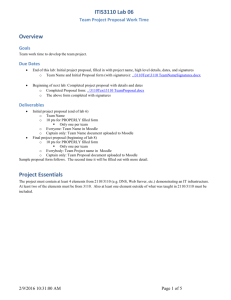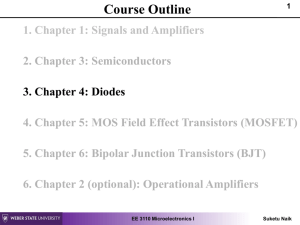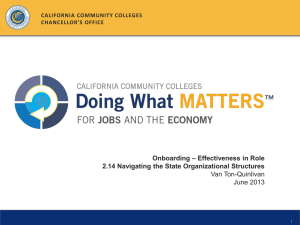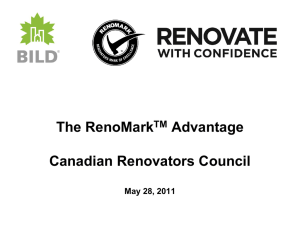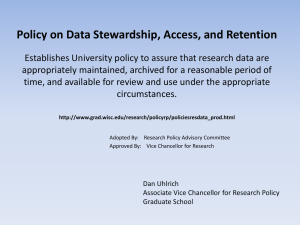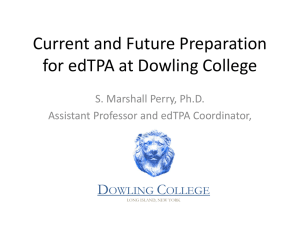AR3110 - Socccd.edu
advertisement
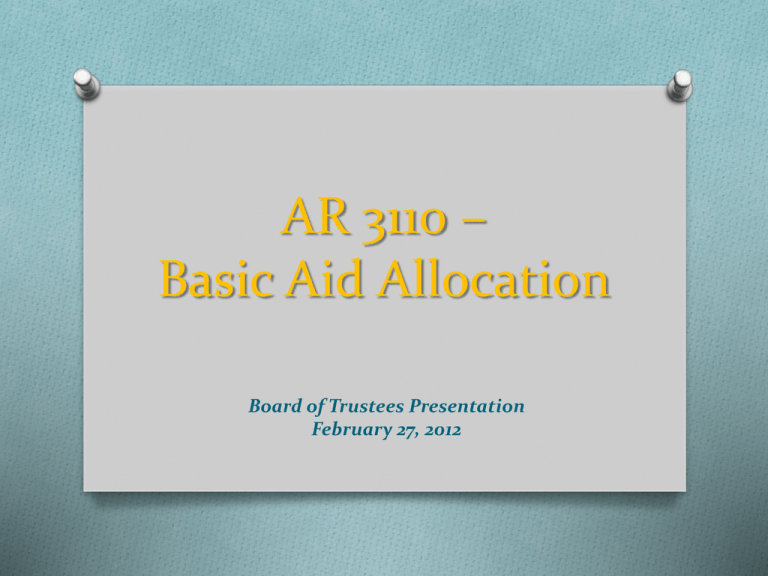
AR 3110 – Basic Aid Allocation Board of Trustees Presentation February 27, 2012 Introductions Background Why AR 311o? Accreditation Recommendation # 2 : “The district and the colleges develop and implement a resource allocation model: • Driven by planning • That includes all district funds and • Is open, transparent, inclusive, and • That is widely disseminated and • Reviewed/evaluated periodically for effectiveness” Background (cont.) Accreditation Recommendation #2 Committee: • Based on general consensus of the input across the district, determined that the issues were not with the DRAC Model but with allocation of basic aid resources • Developed illustrative model to provide information regarding planning and resources for better communication • Instrumental in getting BP 3110 developed • AR 3110 was the next step in implementation Put left half of flow chart here BP 3110 Board Policy for Basic Aid Funds Allocation Process (Exhibit A): • To be based on planning documents • Board determines timing and how much allocated each year • Reasonable amount not allocated until assurance of availability of resources or if needed for potential unexpected needs BP 3110 Board Policy for Basic Aid Funds Allocation Process (Exhibit A): • To be allocated for the follow purposes: 1. Capital construction, major renovation, large infrastructure projects, and site development to follow district & college strategic plans, Education and Facilities Master Plan, 20 year Facility, Renovation, and Scheduled Maintenance Plan and 5 year Construction Plan BP 3110 Board Policy for Basic Aid Funds Allocation Process (Exhibit A): • To be allocated for the follow purposes: 2. Retiree benefit trust fund and other long term obligations 3. Trustee elections, legislative advocacy, major legal fees & judgments 4. Major technology initiatives as identified in District and College Tech Plans BP 3110 Board Policy for Basic Aid Funds Allocation Process (Exhibit A): • To be allocated for the follow purposes: 5. 50% matching funds for scheduled maintenance and small renovation projects including maintenance equipment as identified in 20 year Facilties, Renovation, and Scheduled Maintenance Plan. The other 50 % funded by the college and allocation will be based on DRAC ratios used in the model AR 3110 – Basic Aid Allocation Board of Trustees Presentation February 27, 2012 AR 3110 • Follows BP 3110 • Will culminate in a master list of projects to be funded by basic aid which follows the budget cycle • Allocation cycle will conform with budget development cycle • Linked to property tax schedule and conservative estimates • Unless emergency situation, the cycle will be followed BAARC • District-wide participatory governance committee whose role is to implement the Basic Aid Allocation Process • Charged with implementing BP 3110 and AR 3110 • Utilizes plans developed by other district-wide councils and committees • Follows the annual basic aid allocation cycle which follows the budget cycle BAARC Composed of 17 positions: • Vice Chancellor of Business (chair) • Vice Presidents of Instruction (2) • Directors of Facilities (2) • District Directors of Facilities and Fiscal Services (2) • Directors of Fiscal Services (2) • Academic Senate Presidents and/or reps (4) • Vice Chancellor of Technology and Learning Services • Classified Senate Presidents or reps (2) • CSEA rep (1) Determining allocation amounts: (Refer to page 3 of 7 of the AR) • Conservative estimation of property tax excess • Unallocated balance from PY + estimated CY = Total estimated property taxes for basic aid • Contingency for Unrealized Tax Collection = no less than 20 % • Amount available for allocation = no more than 80% of Total estimated property taxes for basic aid • Committee can allocation less than 80% if it’s appropriate Allocation process: (Refer to page 4 of 7 of the AR) • Required amounts for Long Term Obligations such as Retiree Benefit Liability and fixed expense commitments such as Advocacy and Legal Costs will be funded first because they are liabilities, not discretionary • Remaining balance will fund: a) capital construction, major renovation, large infrastructure, and site development; b) major technology initiatives; c) 50 % match for scheduled maintenance, smaller renovation projects, and maintenance equipment Allocation process: (Refer to page 5 of 7 of the AR) • Majority portion of basic aid intended for areas of capital construction, major renovation, large infrastructure, and site development • Allocation of scheduled maintenance will be based on distribution ratios between the colleges used in the DRAC model for specific projects Allocation process: • Capital Improvement Committee (CIC) will be the district wide participatory governance committee responsible for definitions of capital construction and other facilities related terms • Common definitions, transparent, and clear • Allocations must be used within 5 years on the specific project for which funding was approved • Any remaining funds return to the basic aid fund for reallocation in the next year Allocation process: • BAARC can recommend funding for a project that has phases over multiple years, if appropriate. • BAARC is to rely strongly upon existing priorities in the plan documents • However, may have to consider Total Allocation amount, queuing of projects for state funding consideration, phasing considerations, cash flow, and melding the various plans into one recommended list for basic aid allocation recommendation • Capital projects will include a change order contingency Allocation process: • Any Major Tech Project for consideration for funding must be included in the District-wide Tech Plan and must clearly be a one-time project: • • • • • • Clear description Detailed scope Specific dollar amount If phases, much be outlined Ongoing maintenance not to be funded by basic aid Changes and/or enhancements or added features to projects require a new request and cannot be funded through original project allocation Making recommendations: • The Basic Aid Recommendations will be made to the Chancellor, who will share and confer with the Presidents before making final recommendations to the Board of Trustees • • • • • Master list of projects, with project description, recommended amount, and scope Future phases will be clearly disclosed with projected future costs and timing Cover letter and narrative report from BAARC explaining the process, considerations, background Chancellor should have If the Chancellor recommends any changes to BAARC’s recommendation, the chancellor will clearly provide the changes and explanations prior to their being included in the Tentative and Final Budget for Board of Trustee approval If consensus cannot take place in BAARC, chair will bring issue to Chancellor who will be authorized to make final decision Evaluation: • There will be evaluation of BP 3110 and AR 3110 for effectiveness and adherence to the Policy and Administrative Regulation • Once a year, open and transparent • Make recommendations for improving or adjusting process • Communication of the results of the assessment will be widely disseminated • Any adjustments to the process will be widely disseminated and keep with the intent of the BP and AR Where can I find more information? Here are the SharePoint links to the following pages: • District-wide Planning Council: https://sharepoint.socccd.edu/chancellor/dp/dwpc/default.aspx • DRAC: https://sharepoint.socccd.edu/sites/dwc/drac/default.aspx • BAARC: This new SharePoint site was just established: http://sharepoint.socccd.edu/sites/dwc/baarc Thank you New BAARC Members Bob Bramucci Lisa Davis Allen Dan Walsh Bruce Gilman Craig Justice Don Busche Don Mineo John Edwards John Ozuravich Carol Hilton Davit Khachatryan Earlene Munder Jan Mastrangelo Debra Fitzsimons Kim McCord Brandye D’Lena 1st committee meeting is March 9th! Questions?
